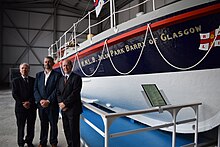RNLB Julia Park Barry of Glasgow (ON 819)

| History | |
|---|---|
| Operator | Royal National Lifeboat Institution |
| In service | 1939–1969 |
| Homeport | Peterhead, Scotland, United Kingdom |
| Official Number: | ON 819 |
| General characteristics | |
| Class and type | Watson-class lifeboat |
| Displacement | 20.5 tons |
| Length | 46 ft (14 m) |
| Beam | 13 ft (4.0 m) |
| Height | 22 ft (6.7 m) |
| Propulsion | Twin diesel engines |
| Speed | 8.5 knots (15.7 km/h) |
RNLB Julia Park Barry of Glasgow (ON 819) is a former RNLI Watson-class lifeboat that was in active service in Peterhead, Scotland from 15 June 1939 to 14 January 1969.
The vessel's sea trials took place on the Holy Loch before making her way from the Clyde through the Forth and Clyde Canal to her new home in Peterhead. At the time, the 46’ (14m) long by 12’ 9” (3.9m) Julia Park Barry of Glasgow was one of the most modern and powerful of the many RNLI Lifeboats that had been built by Messr’s Alexander Robertson and Son’s, one of the foremost wooden boat-builders on Scotland's River Clyde. The vessel had 40 h.p. diesel engines which drove twin screws giving the Julia Park Barry a speed of 9 knots and had the capacity to travel 215 miles at full speed. The engine itself was water-tight meaning even if the engine room was flooded, it would continue to run.
The vessel was designed to hold a crew of eight but could in addition carry a further 95 persons even in the roughest of storms. This buoyancy was aided by the nine watertight compartments which also provided further strength to the vessel design. It was also installed with electric lighting and searchlight and was equipped with a line-throwing gun.[1]
During its near 30 years of service, RNLB Julia Park Barry of Glasgow saved 496 lives.[2] Notably, it facilitated the rescue of 106 lives in March 1942 over a 75-hour period, which earned Coxswain John B McLean the RNLI Gold Medal, the first to be awarded in Scotland in 104 years.[3]
The 46 feet (14 m) vessel, most recently berthed in Northern Ireland after being used as a leisure craft, was then purchased by Professor Sir Lewis Ritchie OBE FRSE (General Practitioner Peterhead 1980-2017) with a view to returning it as an exhibition piece to the town.[4] After being stored by Peterhead Port Authority for a few years, it was then relocated to Admiralty Gateway, site of Peterhead Prison Museum in May 2015.[5] where it was fully restored during 2018 [6]
It became centrepiece of the Julia Park Barry Building, a museum retelling the story of the vessel, and history of lifeboats in Peterhead.[7] The museum was officially opened by Professor Sir Lewis Ritchie on 28 June 2019.[8]
References[edit]
- ^ "Motor Vessel RNLB JULIA PARK BARRY OF GLASGOW built by Alexander Robertson & Sons Ltd in 1939 for Royal National Lifeboat Institution, Lifeboat". www.clydeships.co.uk. Retrieved 20 September 2019.
- ^ "RNLI Peterhead Lifeboat Station - 144 Years of Lifeboats". Peterheadlifeboat.co.uk. Retrieved 26 March 2013.
- ^ "1939–1945: Second World War - Timeline - Our history". rnli.org. Retrieved 20 September 2019.
- ^ Published on Tuesday 29 January 2013 03:00 (29 January 2013). "RNLI values were key to lifeboat purchase - Local Headlines". Buchan Observer. Retrieved 26 March 2013.
{{cite web}}: CS1 maint: numeric names: authors list (link) - ^ "Final voyage for Julia Park Barry lifeboat". www.buchanobserver.co.uk. Retrieved 20 September 2019.
- ^ Gray, Tamsin. "Restoration works begin on lifeboat which served the north-east for 30 years". Press and Journal. Retrieved 20 September 2019.
- ^ "Lifeboat Museum – Peterhead Prison Museum". Retrieved 20 September 2019.
- ^ Proctor, David. "Famous Peterhead lifeboat goes on display after restoration". Press and Journal. Retrieved 20 September 2019.
